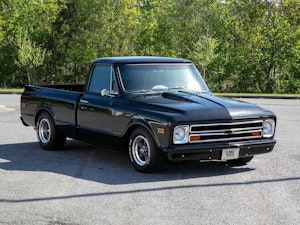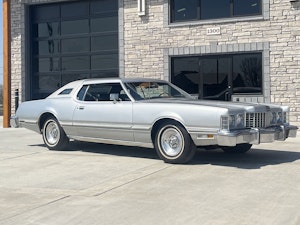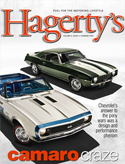Chevy’s “pony car” streaked out of the gate three years after the Mustang but has captured its own loyal legions in the decades since.
A World without Camaros? Say it ain’t so.
Chevrolet’s once-popular compact cruiser surely qualified as an American automotive icon, but that didn’t stop General Motors execs from axing their venerable rear-drive F-body legacy in August 2002, killing off both the Camaro and its corporate cousin, the Pontiac Firebird.
Word of this execution had circulated well in advance, but such forebodings did little to ease the shock, certainly among diehard enthusiasts who never have been able to get enough of their favorite four-wheeled fun machine dating back to its introduction. Like Ford’s still-popular Mustang, wasn’t Chevy’s seemingly invincible pony car supposed to run forever?
Mustang owners were left to gallop on alone – but not for long. In August 2006, then-GM chairman and CEO Rick Wagoner announced that Camaro would be born again. The announcement came after visitors to Detroit’s North American International Auto Show had gone gaga over the sensational Camaro concept vehicle the previous January. “Camaro is much more than a car; it symbolizes America’s spirit and its love affair with the automobile,” Wagoner said.
Making its debut
The all-new 2010 Camaro finally debuted this spring, making it five generations for the bloodline. The second ran from 1970 to 1981, the third from 1982 to 1992 and the fourth from 1993 to 2002.
The first Camaro debuted before the automotive press on Sept. 12, 1966, obviously in direct response to the wildly successful Mustang, itself introduced in April two years prior. Many at GM, including Styling vice president Bill Mitchell and Chevy chief designer Irv Rybicki, had at first poked fun at Detroit’s first pony car, but smiles faded when they started eating Mustang’s dust.
Fortunately, others took the Mustang seriously from the get-go. Recognizing a new sensation when he saw it, Henry Haga in Chevrolet Number Two Studio already had various sketches done when Chevy general manager Bunkie Knudsen got the go-ahead to add yet another new model to an already crowded lineup.
Curiously, a few years earlier Knudsen had shot down Rybicki’s idea for a relatively upscale “personal coupe” based on the Chevy II, claiming that he liked the proposal a lot but that the company didn’t need another new model with Chevrolet’s fifth, the Chevelle, being readied then for its 1964 debut. As Rybicki later recalled, his proposal mimicked much of the Mustang’s makeup at a time when no one at GM even knew Ford’s world-shaker was in the works. But it was not to be.
Attitudes at GM changed after Mustangs started hitting the streets during the summer of 1964. Knudsen was instructed in August 1964 to have Chevrolet’s response – called the F-car – up and running by the fall of 1966, a tight deadline for sure. Haga’s studio then wasted little time sculpting a prototype, code-named XP-836.
As for a marketable name, company insiders at first preferred “Panther,” a moniker also picked up by the press early on. But this tag didn’t stick – after all, it didn’t begin with a “C.” Merchandising manager Bob Lund and GM Car and Truck Group vice president Ed Rollert reportedly put their heads together and came up with “Camaro,” a word that means “friend,” “comrade” or “pal” in French.
Pete Estes, Chevy’s general manager at the time, officially announced his company’s new pony car on June 29, 1966. Like the Mustang, the 1967 Camaro was meant to represent various cars to various drivers, with a budgetconscious six-cylinder starting things off in the basic package. But a flair for fun was still the prime attraction, a fact Estes wasn’t about to overlook when he said, “The Camaro is aimed at the fast-growing personal sports-type market that was pioneered by Chevrolet’s Corvette in 1953 and further defined by the Corvair Monza in the 1960s.”
Quite the performer
Camaro impressed witnesses with its wide-ranging sporting potential, which created quite a dilemma for Chevy customers. The question wasn’t whether to buy the Camaro, rather what kind, for it wore more faces than any other car made at the time. Widening the scope further was the SS 396 model and the fabled Z/28, both introduced in November 1966.
Several tuners jumped into the fray in the late 1960s. Chicago’s Nickey Chevrolet began dropping the Corvette’s 427 big block V-8 between Camaro fenders in 1967, as did Dana Chevrolet in South Gate, California. Berger Chevrolet, in Grand Rapids, Michigan, also offered various tuner Camaros during the 1960s and 1970s, and Joel Rosen’s Baldwin- Motion shop in Baldwin, New York, started swapping in 454-cubic-inch Mk IV big blocks in 1970. But, arguably, the most noted Camaro tuner was a former Chevrolet racer who operated a dealership in Canonsburg, Pennsylvania.
Don Yenko, winner of four Sports Car Club of America national championships, began marketing 427-powered Camaros in 1967. Called “S/C” models (for Super Car), Yenko Camaros were at first shop swaps, and then along came Vince Piggins’ Corporate Office Production Order (COPO) Camaros in 1969. Iron-block COPOs were shipped directly to Canonsburg that year, making the job of building a Super Car considerably less troublesome.
Save for a brief rest from 1975 to midyear 1977, and a transformation into the “IROC-Z” from 1988 to 1990, the Z/28 (or “Z28” as the moniker morphed into along the way) rolled on almost uninterrupted into the new millennium.
Collectible highlights back in the muscle car’s heyday included the rare 375-horsepower L78 renditions of the SS 396, offered from 1967 to 1970, and the even more scarce L89 aluminum-head option, sold along with the L78 in 1969 only. A complete aluminum big block, the Corvette’s ZL-1 427, also appeared as a Camaro option in 1969, along with a cast-iron counterpart. Both were created with performance products guru Vince Piggins’ help, using the clandestine COPO pipeline.
First-generation Camaro convertibles paced the Indianapolis 500 in 1967 and 1969, with the latter made into replicas sold to the public. The original Super Sport model was retired after 1972, as was the second-generation Z28 two years later. And a convertible Camaro didn’t return when the second generation showed up (albeit a little late) in February 1970.
Minor milestone moments came in 1977 when the Z28 returned and in 1982 as a Camaro again paced the Indianapolis 500. The impressive IROC Z28 debuted in 1985, and a convertible Camaro reappeared in 1987 after an 18-year hiatus. As in 1982, another race-day appearance at Indy in 1993 marked the arrival of another next-generation Camaro. And of even more interest that year was the installation of the Corvette’s LT1 small block, introduced the year before, into the fourth-gen Z28.
Mustang GT drivers didn’t stand a chance up against the 275-horse Z, even after Ford’s latest next-generation pony car made the scene in 1994. Chevrolet then turned up the heat again in 1996, teaming with SLP Engineering in Troy, Michigan, to bring back the Camaro SS, powered by a tweaked LT1 rated at 305 horsepower.
Price brings options
A collector certainly has a lot to choose from today, with prices ranging from affordable to unworldly. Presently the world record tag is $800,000 for a 1969 ZL-1 hammered out during a Mecum auction in the spring of 2008.
Various other ZL-1 examples – called “the ultimate Camaro” by Mecum Auctions’ John Kraman – have brought from $480,000 to $575,000 at auction in recent years. More to a mere mortal’s liking, the way-cool 1969 Z/28 brought as much as $100,000 during the market’s boom a few years back but has since come back down to earth.
“The 1969 Z/28s have plummeted, have tumbled,” Kraman adds. “Cars that used to run from $90,000 to $125,000 are now going for $50,000 to $75,000. The ’69 Z/28 peaked with the market in 2005 and 2006 along with all first-generation Camaros.” But that’s not necessarily a bad thing – as long as you’re not one who bought high and now has to sell low.
Purists still love what many agree is the most popular Camaro of all time. “The 1969 Z/28 is a legend, one of the top two or three icons from the performance era,” Kraman says. “Is it the fastest? No. Is it the most rare? No. But it still has developed its own mystique.”
As for what collectors down the road will have to have, Musclecar Enthusiast editor Steve Statham predicts one particularly major player. “Just for sheer performance, the 1996-2002 SS should gain in popularity,” he says.
Statham also is quick to point out that the Camaro still stands as an “everyman’s” car. “I also see a little growing collector activity involving the 1980s cars because prices are so low,” he adds. “People who owned these cars originally are going back and buying them. You can find a nice one for $4,000 or $5,000. For people priced out of the muscle car market, that’s noteworthy.”
With the legacy back, who knows what interest may be rekindled in Camaros of the past. As much fun as enthusiasts have had with the 1960s models over the years, there’s nothing saying later models can’t offer the same rewards. “Many companies are now offering restoration parts for 1970s models, and, in that regard, we are seeing revived activity in the Camaro market,” Statham says.
Perhaps everything that goes around really does come back around.
WANT MORE CAMARO? We could devote an entire issue to Chevy’s pony car and that probably still wouldn’t be enough for you diehards out there. Never fear, you can get your Camaro fix at hagerty.com/camaro, where you’ll find market data from Hagerty’s Cars That Matter, factory literature, links to vintage commercials and more.
***
To see this article in its original format, view the pdf version of the Summer 2009 issue of Hagerty magazine.













